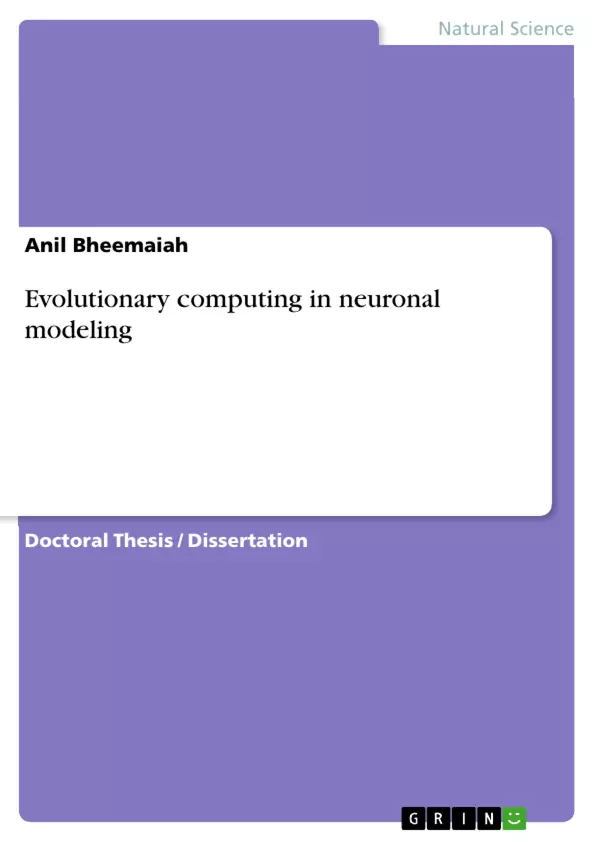The efficacy of genetic algorithms in the design of models that model specific and experimental aspects of action potentials in a wide variety of organisms is proven. A specific example of a plant action potential is used to illustrate the use of genetic algorithms in the search for parameters of models. The efficiency of the genetic algorithms as a search method is in the short generation span of the convergence of the algorithm.
We use the genesis simulator to simulate a single compartmental model of a plant cell. The plant cell has a delayed rectification K channel, a Ca channel and a Ca dependent Cl channel. We have omitted the H+ ATPase pump from the model. The depolarization is by the release of Ca from stores and due to a Ca channel and due to the chloride channel that depends on Calcium. There is an IP3 mediated calcium release mechanism which we have simplified in a model of calcium concentration that decays exponentially with time. The genesis package comes inbuilt with search algorithms that include the genetic algorithm. We use this to run a simulation to search for many parameters including the gbar for the chloride and calcium channels and the time constant and middle point of the potassium channel parameters, Ninf and tauN. The simulations have a time step of 20 micro seconds and are responses of the single compartmental model to current injections of .1 nanoampere to 1.0 nano ampere.
Inhaltsverzeichnis (Table of Contents)
- Abstract
- Introduction
- Methods
- Genetic algorithms
- A simple genetic algorithm
- The simple operator definitions
- How do genetic algorithms work?
- Limitations of "static" schema analysis
- Iterated hill climbing techniques
- Steepest ascent hill climbing(SAHC)
- Next-ascent hill climbing(NAHC)
Zielsetzung und Themenschwerpunkte (Objectives and Key Themes)
This paper explores the efficacy of genetic algorithms in developing models that simulate specific aspects of action potentials in various organisms. It utilizes a plant action potential as an example to illustrate the application of genetic algorithms in searching for model parameters. The paper also examines the efficiency of genetic algorithms as a search method and how they can be used to reduce the effort involved in building compartmental models.
- Application of genetic algorithms in neuronal modeling
- Optimization of model parameters through automated search methods
- Efficiency of genetic algorithms as a search method
- Comparison of genetic algorithms to other search techniques
- Understanding the workings of genetic algorithms
Zusammenfassung der Kapitel (Chapter Summaries)
- Abstract: This section introduces the paper's focus on using genetic algorithms to design models that simulate specific aspects of action potentials. It highlights the efficiency of genetic algorithms as a search method and uses a plant action potential as a specific example.
- Introduction: This section discusses the challenges of neuronal modeling, including the difficulty in deriving model parameters from experiments. It introduces the concept of parameter search algorithms, specifically genetic algorithms, as a solution to address these challenges.
- Methods: This section details the simulation of a single compartmental model of a plant cell using the genesis simulator. It describes the components of the model, including the delayed rectification K channel, Ca channel, and Ca-dependent Cl channel, and the parameters that are searched for using the genetic algorithm.
- Genetic algorithms: This section provides an overview of genetic algorithms, explaining their biological origins and key terminology, including chromosomes, genes, alleles, genotype, phenotype, crossover, and mutation. It also discusses the fitness of an organism and how it relates to genetic algorithms.
- A simple genetic algorithm: This section outlines the steps involved in a simple genetic algorithm, including population initialization, fitness calculation, parent selection, crossover, mutation, and population replacement. It also discusses the importance of parameters such as population size, crossover probability, and mutation probability.
- The simple operator definitions: This section provides detailed explanations of the selection, crossover, and mutation operators commonly used in genetic algorithms. It discusses the purpose and implementation of each operator.
- How do genetic algorithms work?: This section explores the theoretical foundations of genetic algorithms, specifically the Schema theorem, which describes the growth of schemas (building blocks of solutions) over generations. It highlights the role of crossover in the efficiency of genetic algorithms.
- Limitations of "static" schema analysis: This section discusses criticisms of the schema formulation as a static building block hypothesis (SBBH), pointing out two potential reasons for its failure: collateral convergence and high fitness variance. It argues for a more dynamic approach to analyzing genetic algorithm behavior.
- Iterated hill climbing techniques: This section introduces two alternative search techniques: Steepest ascent hill climbing (SAHC) and Next-ascent hill climbing (NAHC). It describes the steps involved in each technique and highlights their differences.
Schlüsselwörter (Keywords)
The main focus of this paper is on applying evolutionary computing, specifically genetic algorithms, to neuronal modeling. Key terms include action potentials, neuronal networks, parameter search algorithms, genetic algorithms, crossover, mutation, fitness, schema theorem, building block hypothesis, and iterated hill climbing techniques.
- Arbeit zitieren
- Anil Bheemaiah (Autor:in), 2018, Evolutionary computing in neuronal modeling, München, GRIN Verlag, https://www.hausarbeiten.de/document/387764


